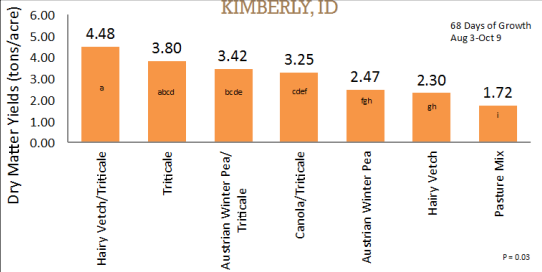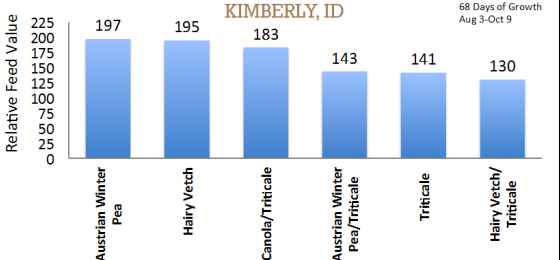By Lauren Hunter and Steve Hines, University of Idaho Extension
Cover crops are traditionally used as a soil-amending tool, but can also be viewed as a temporary pasture with a source of high-quality feed.
Dual-purpose cover crops are utilized by producers wanting to achieve an economic advantage by grazing cover crops before using plant residue for soil improvement.
Integrating cover crops into a crop and livestock system can be economically advantageous and biologically efficient. Properly managed livestock in a cropping system provides a good source of organic nutrients and an efficient nutrient cycling system.
A grazed cover crop field provides soil nutrients from both the cover crops and livestock manure, keeping photosynthetic energy in the field. The grazing activity helps to break down and mix plant matter through ruminant and hoof action, speeding up decomposition.
Planting winter-hardy cover crops as a forage crop is advantageous for extending the grazing season in the fall and leaving residual re-growth for additional spring grazing or for soil residue.
The advantage of selecting winter-hardy cover crops over winter -kill annuals, is additional forage potential in the spring and in some cases, more soil building material through higher yields. Winter-kill crops, like canola, can provide biomass over the fall months while the winter hardy crops are establishing.
The most economical way to utilize a blend of winter hardy and winter kill cover crops is to plant following an early summer harvest, and graze in the fall and spring. Winter hardy cover crops can also be planted as a full-season forage crop.

Figure 1. Biomass dry matter yield for replicated cover crop species trial in Kimberly, Idaho. Biomass yields were collected on Oct. 9, 2012. Planting date Aug. 3, 2012.
A full-season temporary pasture of winter-hardy cover crops is most economically used to graze multiple times in the summer and fall, leaving residual regrowth for spring. The cover crop mix selected by producers plays a role in livestock average daily gain or preference as well as soil nutrient benefits.
Producers in the west commonly select cover-crop mixes comprised of grasses/grains, legumes and canola. The obvious dual-purpose cover crops are legumes, which fix atmospheric nitrogen, and accumulate nitrogen as protein in the above ground forage.
Canola and other brassica species have long taproots and/or horizontal roots that scavenge nutrients deep in the soil profile, primarily nitrogen and phosphorus, preventing nutrients from leaching below the plant root zone.
In order to accommodate higher average daily gains, timing of grazing and plant selection is an important component for managing dual-purpose cover crops. University of Idaho Extension Research: Using a Western Sustainable Agriculture Research & Education and an NRCS Critical Issues grant, University of Idaho (UI) Extension tested the suitability of fall planted cover crop species for high-desert farming systems.
Researchers evaluated yield and forage quality during the fall. A demonstration-grazing period on cover crop plots provided qualitative data on livestock preference.
Dual-Purpose Cover Crop Yield and Forage Quality Results: Forage production in the fall with seven weeks of growth following grain harvest was the highest for hairy vetch/triticale followed by triticale, Austrian winter pea/triticale, and a canola/triticale mix (Figure 1).

Figure 2. Relative feed value (RFV) for replicated cover crop species trial in Kimberly, Idaho. RFV information was collected on October 9, 2012. Planting date August 3, 2012.
Relative feed value (RFV) is a comparison of forage quality to that of full-bloom alfalfa (rated as a value of 100); a RFV above 100 is higher quality than a RVF below 100. For comparisons, good quality Idaho alfalfa hay has a RFV of 170 or higher.
After seven weeks of fall growth the highest cover crop RFVs were Austrian winter pea (197), hairy vetch (195), and canola/triticale (183; Figure 2). The RVF is slightly lower for the legume/cereal blends compared to the 100% legumes, but the advantages of the blends are reduced seed cost and increased forage biomass.
Overall, the source of feed with 68 days of fall growth provided an economical source of high quality feed during a time, typically associated with fallow fields. Contact Lauren Hunter for more information.




Post a comment
Report Abusive Comment